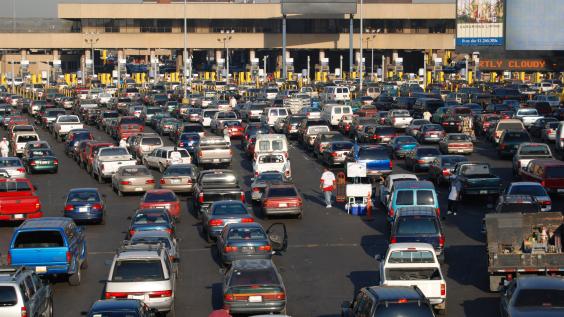Testimony Before the Texas House of Representatives

Table of Contents
Author(s)
This testimony was delivered before the Texas House of Representatives Committee on International Trade and Intergovernmental Affairs on February 23, 2015.
It has been said that geography is destiny. Nowhere is this truer than in Texas, where a close relationship with Mexico has helped define its past as well as its future. In spite of a sometimes contentious 200-year history, the U.S.-Mexico relationship has not only survived but, by almost every statistical indicator, has prospered and pushed ahead. Those statistics include the fact that Mexico is Texas’ number one trade partner. Texas is now the destination and origin of a substantive percentage of trade between the U.S. and Mexico. In addition, more Texas residents today are of Mexican origin than of any other ethnic group. And Texas is a favorite destination for thousands of Mexican tourists and shoppers.
In light of these strong commercial, cultural and social connections, it is important to take a hard look at how Texas and Mexico manage their relationship.
The Texas-Mexico border makes up 1,254 miles of the 1,925-mile-long U.S.-Mexico border. Texas is also home to four dynamic trading hubs: Laredo, El Paso, Brownsville, and Houston. At the same time, Dallas and San Antonio have become major logistics points for overall North American trade into Mexico. All of these Texas cities became major points of entry and exit for trade with Mexico after the passage of the North American Free Trade Agreement (NAFTA). Laredo is today one of the busiest land ports of entry in the United States. Almost two million trucks were processed in Laredo in 2014, and nearly 1.5 million of them carried loaded containers. Almost four thousand trains crossed the Laredo port of entry that same year. El Paso, the second busiest Texas point of entry, processed nearly 750,000 trucks, and almost 400,000 carried loaded containers also in 2014. At the same time, almost 2,000 trains crossed that port of entry.
Another statistic is important to keep in mind: Almost 33 million vehicles were processed at Texas ports of entry in 2014 and 80,300,000 people crossed between Texas and Mexico that same year — most of them legally. Now consider that the total number of detentions of undocumented crossers at the border was just over 241,000 persons in 2014.
All of these numbers indicate that we now need to invest heavily, and without delay, on expanding and making more efficient our capacity to process legal trade and legal border crossers at the U.S.-Mexico border. The general lack of efficiency in handling trade and border crossers is likely costing billions of dollars in commerce, tourism, shopping, and general economic activity — not to mention the enormous cost of air pollution from vehicles idling in long lines. The intersections between Mexico and the U.S. are only expected to grow in the future, and we in Texas would do well do prepare for it.
Mexico, too, is preparing to become even more connected with Texas. One of the country’s major projects is Highway 40, which will connect the port of Mazatlán, in the Mexican breadbasket state of Sinaloa (which already provides many of the fruits and vegetables in the United States), with Matamoros, Tamaulipas, across from Brownsville, Texas. This new connection — a key part of which the Baluarte Bridge project, completed under President Felipe Calderón — will make more accessible a region previously connected only north to Arizona and California with Texas as no direct modern highway connected Mexico’s north on an East-West route. The highway will likely reinforce Texas’ role as a major corridor for additional trade with Mexico and will consolidate the state as a major trade partner for Mexico. Additional railway tracks now being laid from Mexico to south Texas are also a key part of Mexico’s plans to further integrate with the U.S. The new rail connections may in the future connect key population centers of Mexico with Texas and increase the amount of trade between the two.
But such plans do not necessarily indicate that we are doing well. We need to push the U.S. government to either liberate the presidential permitting process for additional crossborder infrastructure and put it in the hands of Texas, or streamline it so as to expedite the permits that are required. Tight federal control of border infrastructure, with little or no participation from local governments, is probably costing in terms of trade and ultimately wealth for both Texas and Mexico.
Recent energy reforms in Mexico are bound to make Houston even more important trade partners with Mexico. Although a quick boom in the energy sector in Mexico is not likely, as it may take several years for energy reform to be implemented, no other city in the United States is better positioned than Houston in terms of expertise, technology, and capital to take advantage of the opening of Mexico’s energy sector.
We cannot conclude a conversation about the future of the U.S.-Mexico binational relationship or the future of the Texas-Mexico relationship without a few recommendations that can facilitate a prosperous future for both.
First, Texas must put much more effort into quantifying its relationship with Mexico and acknowledging its impact in the state. The business community has long understood the importance of Mexico to Texas, but the political elites have made few inroads into understanding and properly dimensioning the relationship with Mexico. Much of its prosperity depends on properly measuring the importance of Mexico to Texas and embracing policies to leverage it for the prosperity of both Texans and Mexicans. For instance, although it has been said that six million jobs in the United States are directly or indirectly tied to trade with Mexico, we do not yet understand the exact impact on Texas employment, although we do know it is substantial. Between 1992 and 2012, the number of U.S. jobs dependent on foreign trade more than doubled to just over 20 percent of the workforce. Texas probably leads the pack and ranks even higher than the U.S. as a whole. If we know the exact number of jobs in Texas that depend on trade with Mexico, we would be able to produce infrastructure policies that make this trade easier at the border.
Most of the trade gains between the U.S. and Mexico were made in the first 10 years of NAFTA. Trade grew at a slower pace in NAFTA’s second decade. NAFTA has, in many ways, given most of what it has to give. Texas must now lead the national effort to expand the commercial framework at the national level — an effort that would result in an increase in trade with Mexico and even Latin America. If Texas led the way for a NAFTA 2.0, it would certainly be creating the conditions for greater prosperity for Texans. And Texas is uniquely positioned to lead this effort, not only because of its geography, but also because of its population — much of which is bicultural and bilingual. These are assets that can be harnessed in this effort.
The time to take a leadership as a state in the U.S.-Mexico relationship is now.
Thank you for your attention.



